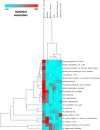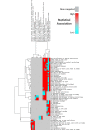Patient-reported outcomes and therapeutic affordances of social media: findings from a global online survey of people with chronic pain
- PMID: 25616273
- PMCID: PMC4319091
- DOI: 10.2196/jmir.3915
Patient-reported outcomes and therapeutic affordances of social media: findings from a global online survey of people with chronic pain
Abstract
Background: Patient-reported outcomes (PROs) from social media use in chronic disease management continue to emerge. While many published articles suggest the potential for social media is positive, there is a lack of robust examination into mediating mechanisms that might help explain social media's therapeutic value. This study presents findings from a global online survey of people with chronic pain (PWCP) to better understand how they use social media as part of self-management.
Objective: Our aim is to improve understanding of the various health outcomes reported by PWCP by paying close attention to therapeutic affordances of social media. We wish to examine if demographics of participants underpin health outcomes and whether the concept of therapeutic affordances explains links between social media use and PROs. The goal is for this to help tailor future recommendations for use of social media to meet individuals' health needs and improve clinical practice of social media use.
Methods: A total of 231 PWCP took part in a global online survey investigating PROs from social media use. Recruited through various chronic disease entities and social networks, participants provided information on demographics, health/pain status, social media use, therapeutic affordances, and PROs from use. Quantitative analysis was performed on the data using descriptive statistics, cross-tabulation, and cluster analysis.
Results: The total dataset represented 218 completed surveys. The majority of participants were university educated (67.0%, 146/218) and female (83.9%, 183/218). More than half (58.7%, 128/218) were married/partnered and not working for pay (75.9%, 88/116 of these due to ill health). Fibromyalgia (46.6%, 55/118) and arthritis (27.1%, 32/118) were the most commonly reported conditions causing pain. Participants showed a clear affinity for social network site use (90.0%, 189/210), followed by discussion forums and blogs. PROs were consistent, suggesting that social media positively impact psychological, social, and cognitive health. Analysis also highlighted two strong correlations linking platform used and health outcomes (particularly psychological, social, and cognitive) to (1) the narrative affordance of social media and (2) frequency of use of the platforms.
Conclusions: Results did not uncover definitive demographics or characteristics of PWCP for which health outcomes are impacted. However, findings corroborate literature within this domain suggesting that there is a typical profile of people who use social media for health and that social media are more suited to particular health outcomes. Exploration of the relationship between social media's therapeutic affordances and health outcomes, in particular the narration affordance, warrants further attention by patients and clinicians.
Keywords: chronic disease; chronic pain; patient-reported outcomes; social media; therapeutic affordances.
Conflict of interest statement
Conflicts of Interest: None declared.
Figures




References
-
- Stellefson M, Chaney B, Barry AE, Chavarria E, Tennant B, Walsh-Childers K, Sriram PS, Zagora J. Web 2.0 chronic disease self-management for older adults: a systematic review. J Med Internet Res. 2013;15(2):e35. doi: 10.2196/jmir.2439. http://www.jmir.org/2013/2/e35/ - DOI - PMC - PubMed
-
- Thackeray R, Crookston BT, West JH. Correlates of health-related social media use among adults. J Med Internet Res. 2013;15(1):e21. doi: 10.2196/jmir.2297. http://www.jmir.org/2013/1/e21/ - DOI - PMC - PubMed
-
- Gibbons MC. Personal health and consumer informatics. The impact of health oriented social media applications on health outcomes. Yearb Med Inform. 2013;8(1):159–61. - PubMed
-
- Wicks P, Stamford J, Grootenhuis MA, Haverman L, Ahmed S. Innovations in e-health. Qual Life Res. 2014 Feb;23(1):195–203. doi: 10.1007/s11136-013-0458-x. http://europepmc.org/abstract/MED/23852096 - DOI - PMC - PubMed
-
- Norman D. The design of everyday things. New York: Basic Books; 2002.
Publication types
MeSH terms
LinkOut - more resources
Full Text Sources
Other Literature Sources
Medical
Miscellaneous

